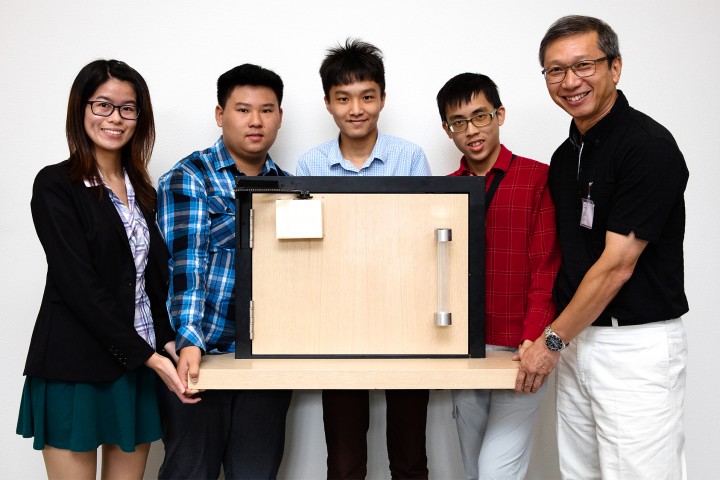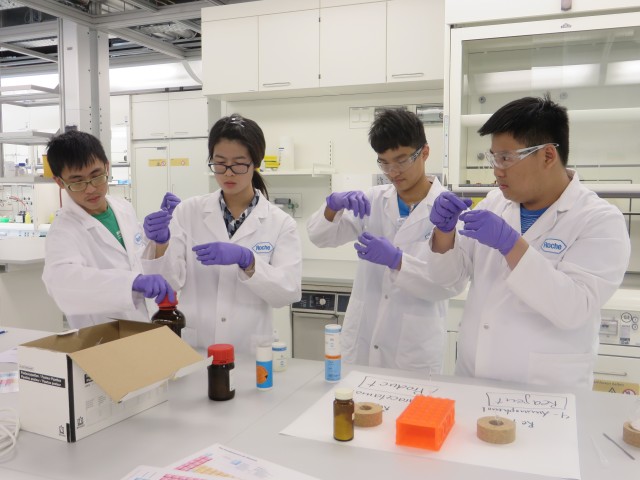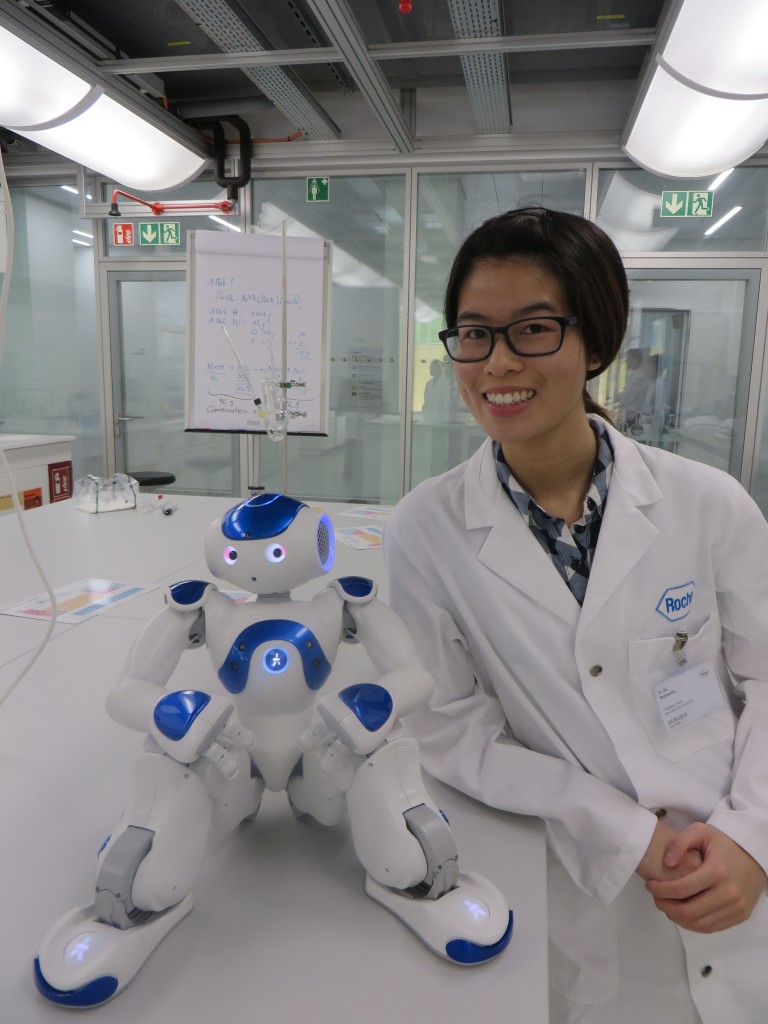One Week with Roche in Switzerland
By Wai Lam Raphaella So 蘇韋霖

This summer, I had the honor of being selected, among 15 students in the School of Science, as the Best Student Mentor for the Roche Young Scientist Award (RYSA) 2015. As the grand prize, Roche sponsored me on a 6-day trip to Switzerland at the beginning of September to not only learn about Swiss culture, enjoy the delicious food, and relax in beautiful scenery; but also, most importantly, to learn about the frontier of biotechnological development. As a student doing life science research, it was an eye-opening experience.
August 31, 2015 (Monday)
Roche History Archive Tour (Basel)
Every scientific discovery has a background story. In the Roche archive, I learned about the successes, as well as the failures, of scientists who dedicated their lives to discovering new potential treatments for diseases. While the successes were inspiring, I found their failures to be more motivating. Stories like their first (but unsuccessful) drug remind me that, even for trained professionals, research is nothing like studying for exams. In school, I would expect to see a positive correlation between hard work and exam scores. Thus, I know I can succeed if I work hard enough. However, in the pharmaceutical industry, as the archive’s curator said, it is quite normal for scientists to work on a product up until pre-release, only to find out that it either does not actually work or it cannot compete against other existing products on the market. To make a successful product, one must have the passion and the courage to persevere through various difficulties.
Thus, my visit to the archive did not consist of a lot of scientific learning, but rather gave me a reality check. The stories advised me of the road ahead and warned me of its perils; but what is more, they reaffirmed my love for scientific discovery and encouraged me to walk on.
Roche Pharmaceuticals Tour (Basel)
I think the most fascinating thing I learned at the Roche pharmaceutical laboratories was how routine laboratory work can be automated. In academia, we usually work with 96 well plates when we want to do drug testing. Thus, we can only work with 96 different samples at once. However, at the high throughput screening laboratory, they use robotic machines to perform the drug screening process. The robot is able to peel the plate cover, add the target protein, the tested drug compound, and the drug substrate all very robustly and accurately. Because of such accuracy, they are able to split the 96 well spaces by a factor of 16, thereby creating plates with over 1500 wells each. Hence, the robots can screen through a lot of potential drug treatments for specific diseases at a much faster pace than in academic laboratories.
Other similar devices exist in their high content screening laboratory, their crystallization laboratory, etc. Again, they use robots to accomplish tasks that are often very labor-intensive for the human hand. In high content screening, they can perform time lapse microscopy of cells and quantify any differences between samples using the robot and computer software. Meanwhile, in order for me to perform a time lapse microscopy experiment of my own, it would require an hour just to set the focus and image positions for my microscope. The same can be said about their crystallization robot – only a few seconds are needed to prepare crystallization reactions, while the same process can take hours if done manually.

September 1, 2015 (Tuesday)
A Visit to a Local Secondary School – Kantonsschule (Wettingen)
Despite being on “holiday” during the first week of school, I also attended class on September 1st. I went to visit a local secondary school in Wettingen named Kantonsschule. The school has a rich history, and its setup is quite different from normal secondary schools in Hong Kong. Students ranged from between 16 to 20 years of age, and the older students were surprised that, while I share the same age as them (20), I am already in my third year of university.
We visited the biology laboratory and attended their class. I was surprised to find micropipettes, as they are typically only used at the university level. In contrast, my high school back in the United States had to rent a mobile laboratory in order for us to learn how to use them. At Kantonsschule, however, they had regular access to such sophisticated apparatus, and were able to use them in a microbiology lab.
The class was split into four groups to do different experiments on bacterial contamination. I joined a group that tested different water sources. We filtered the water samples for bacteria, and then grew the bacteria from the filter on a nutrition plate. The objective of the experiment was to count the number of bacterial colonies formed, thus comparing contaminant levels in different water samples. The experimental technique was taught to me in a 3000-level course, so I was surprised that the students there got to experience it in high school.
In conclusion, I was slightly surprised how similar, yet different, secondary education in Switzerland can be. While they use the same Advanced Placement (AP) Biology textbook as I did in the United States, the course material is much more enriched. It is obvious that their AP Biology program does not only teach them to take the exam, but also includes out-of-syllabus, for-your-interest topics that others usually learn in university. I can only imagine, after having gotten so much exposure in high school, how successful Dr. Ginsburg’s students would be if they decided to continue studying life science in university.
September 2, 2015 (Wednesday)
My Experience at the EXPERIO Roche School Laboratory (Kaiseraugst)
Roche has a laboratory where local students, from primary schools to universities, can visit and conduct half- or full-day experiments. We studied at their chemistry laboratory that day, and it was quite an intensive learning experience.
First, we were directed to a classroom to sit and learn about the chemical reaction involved. It was the chemical synthesis of paracetamol, which is the active ingredient of a very common drug, Panadol. In the classroom, we were asked to predict the organic structures of our reactants and products, as well as to draw the reaction equation. I was immediately stumped, as I had never learned this much organic chemistry. For the RYSA winners and the Roche staff, the classroom session was even more challenging, as they do not have the high school chemistry background to know how to calculate expected yield. At the end, we completed the written tasks under the instructor’s guidance, and proceeded to the chemistry lab to do the actual experiment.
While waiting for our product to form, a lab assistant entertained us with his robot project. I was so stunned when the robot performed the Macarena dance, Tai Chi, and told jokes. Having never done robotics before, the programming technology left me standing in awe, and words cannot describe how surprised I was with what modern robotics is capable of.
From the lab instructor, I learned about the apprenticeship program in the Swiss education system. Apparently, it is common for students to drop out of high school or university because they decide it is not the right path for them. However, instead of narrowing their futures, Swiss dropouts can find a subject they are passionate about, such as chemistry, and become an apprentice. Of course, the apprentices still need to go to school, but their school time is divided between on-the-job training and taking relevant classes. Thus, they are not forced to learn things they do not enjoy and can focus on pursuing their dreams. Furthermore, their society would gain a diverse array of workers who have much more practical experience.
In fact, the EXPERIO laboratory is populated by apprentices that graduate to become lab assistants. Furthermore, graduated apprentices may also choose to reenter academia by studying in an applied sciences university. Therefore, unlike Hong Kong students who may only be in university so they can find a job with the degree, Swiss students are given many choices and are thus very passionate about their learning. The apprenticeship system is so successful that it is slowly spreading to other European countries.

September 3, 2015 (Thursday)
Roche Diagnostics Tour (Rotkreuz)
After seeing the pharmaceuticals division, a visit to the diagnostics division was obligatory. There, we saw a machine that could screen hundreds or thousands of samples for specific viruses each day. The machine was able to automatically extract DNA from the blood samples and amplify viral genes, allowing infections to be identified as well as quantified. It was another example of how robots can do everything more robustly than humans can and I seriously question whether I will still be able to find a job after I complete my tertiary education.
September 4, 2015 (Friday)
Museum Tinguely (Basel)
Jean Tinguely was a Swiss sculptor known for using metal scraps to create his art. We had the privilege to visit Muesum Tinguely on our last day to see his great works. Walking through the museum, we saw recycling and design technology at its finest. Tinguely not only created art pieces with waste materials, but he also used motors and other technologies to make his art pieces move and emit sound. Hence, the art changes shape and form every second. For example, the most memorable art is an oscillating object that can turn on the radio. Another masterpiece is the automated drawing machine, which is itself capable of making unique drawings when turned on. The visit was very fascinating, as it revealed a very different way one may apply technological knowledge.